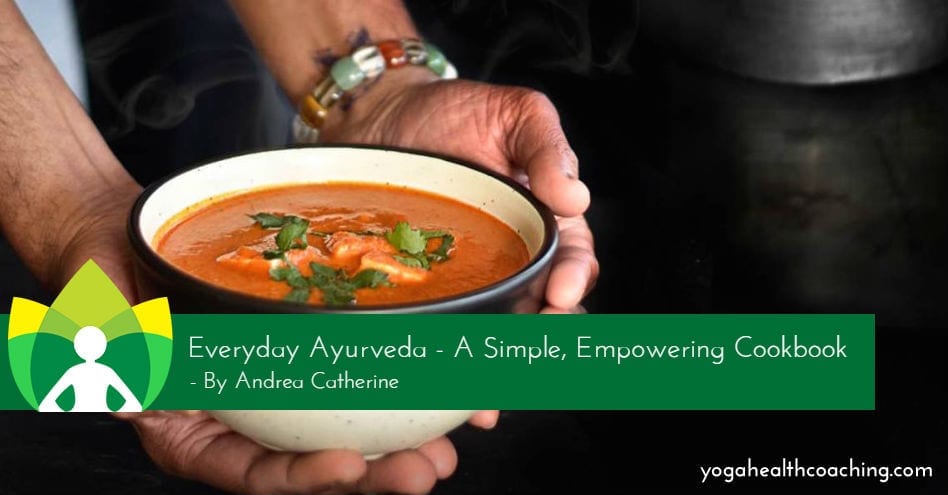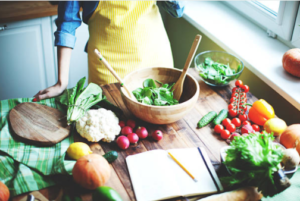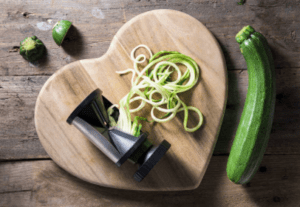
Everyday Ayurveda – A Simple, Empowering Cookbook
When I interviewed cookbook author, Ayurveda expert and yogini, Kate O’Donnell, I wished I had her cookbook in my hands. The minute her new book Everyday Ayurveda appeared on the display shelf in the Kalispell, Montana library, I snagged it up. I loved to look at this cookbook. I admired it’s beautiful design and the simplicity of the recipes. I jumped at the opportunity to interview Kate for the Yoga Health Coaching Podcast. She so inspired me that I knew I needed to invest in my own personal copy. It arrived in perfect time. I received it at time of need for me, a time when I longed for extra nourishment and companionship. Somehow cookbooks can do this for us. They become like much needed friend in the kitchen.
When I cook, I am in my happy place.
I can cook in the day, I can cook in the night.
I like it in dark and I like it in the light.
I cook in the silence, I cook with tunes on.
I cook with friends, I cook when everyone’s gone.
I like it in the kitchen, I like it in the woods.
Cooking makes me happy more than even I have understood.
While Sam I Am’s friend hates green eggs and ham anywhere, I love to cook anywhere!

When Kate’s book arrived, I brought it with me to a camp where I was the hired chef. Amidst the dust blowing outside the kitchen tent, the shiny and new book looked a bit out of place, but at the same time, it’s reflections of the natural rhythms of the seasons fit perfectly in this outdoor learning center. Kate’s South Indian Sambar (p. 124) inspired the lentil dish I made for the 10-12 year old campers and the elders that came to the camp to support the young ones. My favorite comment came from a young camper who piped up to tell me that the dish he ate was much better than he’d expected. In fact, almost every kid thanked me for the good food that evening.
What I like about Kate’s book the most is it’s accessibility. Indeed, Kate’s vision was to create a cookbook with simple, easy-to-follow recipes that anyone could follow. Below is an abbreviated version of our Yoga Health Coaching Podcas conversation, which you can also listen here. It’s fun to get to know Kate by hearing her voice, so I highly recommend listening to the full interview when you have the time.
Excerpts from my Interview with Kate O’Donnell
Kate O’Donnell is a Yoga teacher, who teaches Mysore style yoga in Boston. She is an Ayurvedic practitioner and an author. Ayurveda has been a part of Kate’s life since she traveled to India 20 years ago.
Andrea: Why do you think your book is such a hit?
Kate: The recipes are really simple and it is nice to look at. The books my clients had already tried to use were… too complicated. There is really no use trying to tell someone to modify their diet if they don’t know how or don’t believe they have the time to prepare the foods you’re teaching them about.
Feel Inspired, Excited, Hungry
A: What demand or need did you seek to meet that wasn’t being met in other cookbooks?
K: I moved away from using tri doshas in the cookbook.~Editors note- {Ayurveda emphasizes three different mind/body/spirit types, Kapha, Pitta and Vata. These three doshas are combinations of elements and patterns that can appear in differing degrees in each individual. Honing in on own your Ayurveda ‘type’ can get complicated. Further complicating the matter is that things change with the season, times of day and the time of life you are in(teenager, thirty-something or retiree. All of this can be distracting so Kate O’Donnell focused the recipes in Everyday Ayurveda on foods that work for all people most of the time.
Time and time again I would be sitting with a client…that didn’t feel confident in knowing what dosha they should be cooking for, or what to do if they had a family. I wanted [people] to feel inspired, excited, hungry. I wanted people to feel legitimate hunger for real food, just simple food. When I was working with groups all the time it really wasn’t appropriate to get into the VPK(categorizing recipes according to which of the different doshas Vata, Pitta, Kapha should be eating certain foods.) I started gravitating towards diet and lifestyle routines that anyone could take home, [like] cooking to deal with the seasonal effect. If people eat a seasonal diet, they’re 60% ahead of the game already.
[Kate makes the recipes so simple to make, her clients can’t say no;)]
I know this [client] needs more astringency, how can I get them excited about stone fruits and zucchinis?
Did you know that you can sauté zucchinis in ghee for 5 minutes, stick the mixture in the blender with broth, salt and pepper and you’re good to go?!
I started to have narratives of recipes that were not by the book in anyway. I didn’t use any measurements, a handful of this, a pinch of that, and it seemed to work.
I created that first recipe section, Everyday Recipes (Chapter 4), what as an Ayurvedic Practitioner would call tridoshic. I felt like I was offering people a balanced diet.
A: The simplification of your book is beautiful in a way because it’s empowering…you have all the tools you need. The point is really about taking care of ourselves.
K: You don’t have have to read the whole book cover to cover to make [any one recipe]. Cooking is sadhana.
A: Sadhana is not just 6am on your mat, but it can be 6pm in your kitchen.
For Yoga Health Coaches…
A: What’s your number one tip for Yoga Health Coaches who are working with clients who struggle to establish rhythmic & healthy eating habits?
K: Chapter 2: The Rhythm Project. To establish a rhythm, all you really need is one touch point. I would choose one meal, that presented as the least crazy time of day. I would shoot them little paragraphs of 3 options for what to eat. If we as coaches send them in our own words, a recipe, just a real simple little thing. I think that the client is more likely, because of their connection with you, is more likely to make it.
Kate’s Next Book: Everyday Ayurveda Cooking for a Calm, Clear Mind
A: I know you have a new book that you’re working on. What’s different about it & why might Yoga Health Coaches and their clients gravitate toward it?
K: More than half the time, I noticed disharmony in the mind [of a client]. I had to talk about sattva, rajas and tamas! I knew I had to write a book to deal with the mental attributes. It’s separated into three sections: 1) the biggest section is all sattvic recipes — cultivating sattva will balance rajas and sometimes tamas as well, 2) section for calming rajas, including recipes that can stand-in for what stimulates the rajas in the mind, 3) tamas section — invigorating, inspiring, get you off your ass recipes.
Sometimes you just know that it’s in the mind.
Summer Cooling Tip
A: What’s your favorite way to nourish yourself with food in the summer?
K: I eat a lot of fresh herbs; they really cleanse the body. I am a fan of putting parsley, mint, cilantro in everything. Make an herbal water: cook water until it reduces to half with a sprig of mint in it or make fennel tea and drink at room temperature. Helps to deal with excess water and oily qualities, or manage the heat.
For more about Kate O’Donnell, visit her website.


